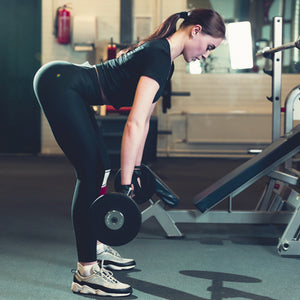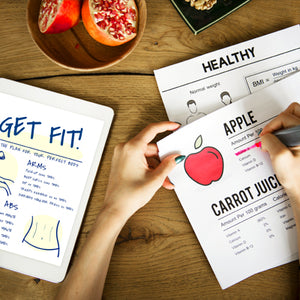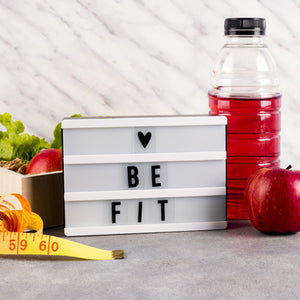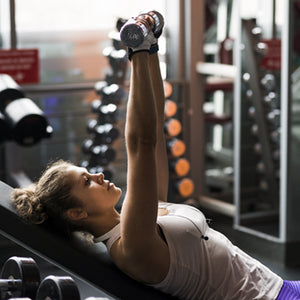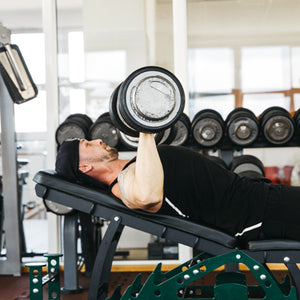| Try Now!

Female Athlete Triad and the Dangers of Low Energy Availability
Female Athlete Triad sounds like some kind of race or triathlon for women. It conjures images of a competition, a proving ground for the best women athletes to compete in three events. Unfortunately, it isn’t that cool and there are no winners. Female Athlete Triad is a combination of three symptoms that women athletes are susceptible to when they burn more energy than they are taking in.
Energy Deficiency
The Female Athlete Triad gets kicked off by consuming less nutrition – read: food – than what is needed to fuel intense activity. Often, there is an eating disorder attached to this symptom, but not always.
Sometimes, it is as simple as someone being ignorant of their total daily energy expenditure (TDEE). Another common reason is maintaining specific weight classes for sports.
Related - Build a Perfect Butt
Women and girls are often pressured to “look pretty” and stay slim, while simultaneously training hard and pushing themselves to their limits. Women and girls are also more accustomed to a larger societal influence, outside of athletics, to under-eat, so they don’t always realize they are doing it.
Being “on a diet” is quite common for women at some point in their lives. While male athletes are celebrated for getting bigger, female athletes are usually condemned for it, both socially by their unathletic peers, and professionally, by their coaches who are often asking them to lose a few pounds.
On top of that, female body composition standards have changed. Women are inundated with images of rippling six packs and shredded delts. Physique competitors and top female CrossFit athletes have brought the bodyfat expectation down dangerously low. Unfortunately, extremely low body fat affects women’s bodies much more than it affects men’s bodies.
Amenorrhea
Amenorrhea is the fancy term for not getting your period. Once women reach a very low body fat level, menstruation ceases. Most women and girls see it as a blessing, but in fact, it is abnormal and a sign of dysfunction. If a female athlete spends too long in an amenorrhoeic state, the imbalance of hormones can have far-reaching consequences.
When a woman is not getting her period, it usually means she lacks estrogen. Estrogen plays a large role in a woman’s body. Not only does it widen the hips and help develop breasts, but it also creates a healthy vaginal environment that aids in a pain-free sex life, and regulates pH balance to discourage bacterial growth and infection.
Aside from all of the lady-centric jobs, estrogen also contributes to healthy hair and skin, thyroid function, cholesterol regulation, heart health, mood, and bone density. As thrilled as many post-menopausal women are to leave their period behind, they are not so thrilled with all the side-effects of low estrogen levels.
Osteoporosis
Rounding out the triad is Osteoporosis. Bones are in a state of perpetual flux between building and resorption, much like all the other cells in our bodies.
Osteoblasts create new bone and osteoclasts resorb old bone. While this process includes many different hormones and polypeptides, estrogen primarily helps osteoblasts build and indirectly prevents osteoclasts from too aggressively resorbing old cells.
When estrogen is low, bone can’t rebuild itself as well, and there is less regulation on resorption, so it becomes porous and prone to fracture. Unfortunately, this is usually the first symptom that brings the female athlete in to see a doctor.
As far as osteoporosis is concerned, a portion of the damage is done. There are ways to regrow some bone mass and strengthen the remaining bone through diet, supplements, and medication, but it is more difficult to restore completely if it has gone unchecked for a long time or if the athlete is over 30.
This is a concerning issue since women need all the bone strength and density they can get before menopause, which naturally weakens their skeletal system. Some female athletes are experiencing osteoporosis in their teens, twenties, and thirties because of a demanding training regimen, plus a lack of understanding about their nutritional needs.
Who is Most at Risk?
Endurance athletes are a higher-risk because the energy requirements to swim, row, run or perform for long periods of time are far higher than most people realize. Thousands of calories can be burned, especially when a female requires extra energy for hormone balance and menstruation.
Physique-dependent sports, like gymnastics and bodybuilding, can put women at risk as well, due to their inherent dependence on extremely low body fat, plus hours and hours of resistance training. The judging of these sports is subjective and based on the athlete’s appearance along with – or instead of – their performance. Ultra-low-calorie diets are common.
Wrestling, mixed martial arts, and sports that separate weight class are also higher-risk. Most sports encourage a fighter to be as big and strong as they can offseason, then cut down to be dominant in a lower weight class to compete.
Men are known to cut 15-20 pounds within a few weeks. The female athlete’s body is not as efficient at a weight cut as her male counterpart, plus women are more prone to water retention and it is trickier for them to lose weight quickly.
They often try to hover as low as they can, which may deprive them of adequate nutrition.
Female athletes on low carbohydrate diets can get themselves into trouble because there is a direct correlation between carbohydrate availability and reproductive and skeletal health. Low carbohydrate diets are the typical go-to of athletes trying to lose weight, but carbohydrates are also the body and brain’s primary fuel for energy. Where there is a deficit, there is low energy availability. And where there is low energy availability, there is the beginning of Female Athlete Triad.
The Elephant in the Room
We can’t explore low energy availability and the Female Athlete Triad completely without touching on eating disorders among female athletes. The high-risk scenarios previously mentioned can lead to triad symptoms without an eating disorder present. It can be unintentional or caused simply by following a coach’s protocol.
However, it is easier to mask an unhealthy obsession with weight and body image behind a so-called “healthy” obsession with physical fitness and sport. When people think of anorexia, they picture a rail-thin wisp of a woman, not a swim medalist with visible muscle. The image of bulimia we conjure usually looks more like “skinny fat” than a jacked CrossFit competitor. It is surprisingly easy to look healthy and be anything but.
It is also easier for a previously healthy woman to slip into an eating disorder, especially when appearance is critiqued and the demands of excellence are high. When girls are already involved in athletics before puberty, it can be devastating when their bodies begin to change and they gain weight and begin to carry more body fat. Add the hormones and self-esteem issues ubiquitous to the teenage years and you have a real danger zone.
How Can We Better Diagnose Female Athlete Triad?
The goal is to detect low energy availability before the other symptoms present. Early detection would prevent the damage long periods of low estrogen can do, including osteoporosis.
Female athletes should have regular physical examinations. During these examinations, they should have their diet and self-image assessed, as well as their bodies. Questions from the physician are fine, but questionnaires are often better, because they feel more anonymous. These are helpful, especially with teenagers, who tend to be embarrassed and clam up when adults ask them direct questions.
The recommendations for a thorough health history examination are as follows: [1]
- Nutritional history - Nutritional intake and eating patterns, quantity of protein, carbohydrate, vitamins, and minerals consumed.
- Menstrual history - The age at menarche, average length of menses, average time between menstrual periods, menstrual changes with increased training, and number of cycles annually. Pregnancy should be excluded in the case of amenorrhea.
- Endocrine/metabolic history - Any personal and family history of thyroid disorders, pituitary disorders, and diabetes should be sought. Obtain signs and symptoms of polycystic ovarian syndrome,
- Psychosocial history - Discuss eating patterns. The Eating Disorder Inventory (EDI) may be used. Document any alcohol, tobacco, or drug use. Ask about social support, depression, anxiety, and any history of physical, emotional, or sexual abuse.
- Performance history - Ask about changes in strength or performance.
- Medication history - Review all medications, dietary supplements, and herbal agents. Obtain information about oral contraceptives separately as patients often do not consider this a medication. Ask about any anabolic steroid use. Determine if the patient uses emetics, diet pills, stool softeners, or laxatives.
As for the physical exam, it is important to check for signs of an eating disorder, as well as collect a full panel of bloodwork to make sure hormone levels are balanced and there is no anemia. The recommendations are as follows:
- Thyroid should be palpated for evidence of enlargement or irregularity.
- Pay particular attention to the teeth, noting tooth decay from repeated vomiting and subsequent hard brushing, and parotid glands for evidence of hypertrophy, as with bulimia nervosa.
- A thorough skin exam should also be performed.
- A pelvic examination should be performed when appropriate, particularly when a patient presents with delayed or disordered menarche.
- A complete metabolic panel to assess electrolyte levels, renal function, and hepatic function and a complete blood cell (CBC) count to evaluate for anemia.
- A thyroid panel to assess for thyroid dysfunction.
- Secondary lab tests involve testosterone (free and bound), luteinizing hormone, follicle -stimulating hormone, estradiol, and prolactin levels
If a female athlete presents with menstrual irregularities or stress fractures, those must be taken very seriously and investigated to rule out Female Athlete Triad. Physician awareness is key.
Prevention Over Detection
Even better than detecting low energy availability before it escalates, would be to prevent it in the first place. When women under-nourish their bodies, there are long-term consequences, even post-recovery.
- The first step is to educate coaches and physicians on the dangers of Female Athlete Triad and what symptoms to keep an eye on. Moodiness, depression, a dip in performance, or erratic behavior can be earlier signs of low energy availability. Stress fractures are a later symptom, and will require a longer recovery period.
- Coaches should also have extensive education in regards to eating disorders and proper nutritional intake for female athletes. They should emphasize healthful eating and discourage big weight cuts or unrealistic bodyfat standards.
- Coaches of school-aged girls should be understanding and encourage adequate rest and time to study.
- We must train female athletes to perform closer to their natural weight class and not try to cut extreme mounts of weight.
- Creating a fitness culture that emphasizes performance over aesthetics and celebrates skill over size will foster an environment of self-esteem and positive goal-setting.
- Pre-pubescent girls should not be pressured to lose weight or look a certain way. They should be judged on the merits of their enthusiasm and their training progress, not their bodies. Female athletes should be regularly evaluated by a physician, a dietician and a mental health professional to make sure they are on track and to treat any accidental or intentional lapses in energy availability as soon as they arise.
Women have slightly different nutritional needs than men and it is easier to overlook under-nourishment because they are encouraged to be thin. Not only that, but there is an underlying sexist notion that women are over-emotional, so mood swings caused by low energy availability or simply persisting in a state of poor mental health are often dismissed.
Male athletes are pressured to be good, while female athletes are pressured to be both good and beautiful. Beauty standards do not often make a great athlete, so women may struggle in cycles of losing weight and then over-training to compensate for their decrease in strength and stamina. Poor diet, inadequate recovery, and the prevalence of obsessive disorders and eating disorders can not only ruin an athletic career with incredible potential, it can also ruin the woman’s health.
We need to have this discussion in the fitness community and put the focus back on the athlete, not the athlete’s body.
References
1) "Female Athlete Triad - StatPearls - NCBI Bookshelf." National Center for Biotechnology Information, 27 Oct. 2018, www.ncbi.nlm.nih.gov/books/NBK430787/.
2) "Female Athlete Triad - StatPearls - NCBI Bookshelf." National Center for Biotechnology Information, 27 Oct. 2018, www.ncbi.nlm.nih.gov/books/NBK430787/.

